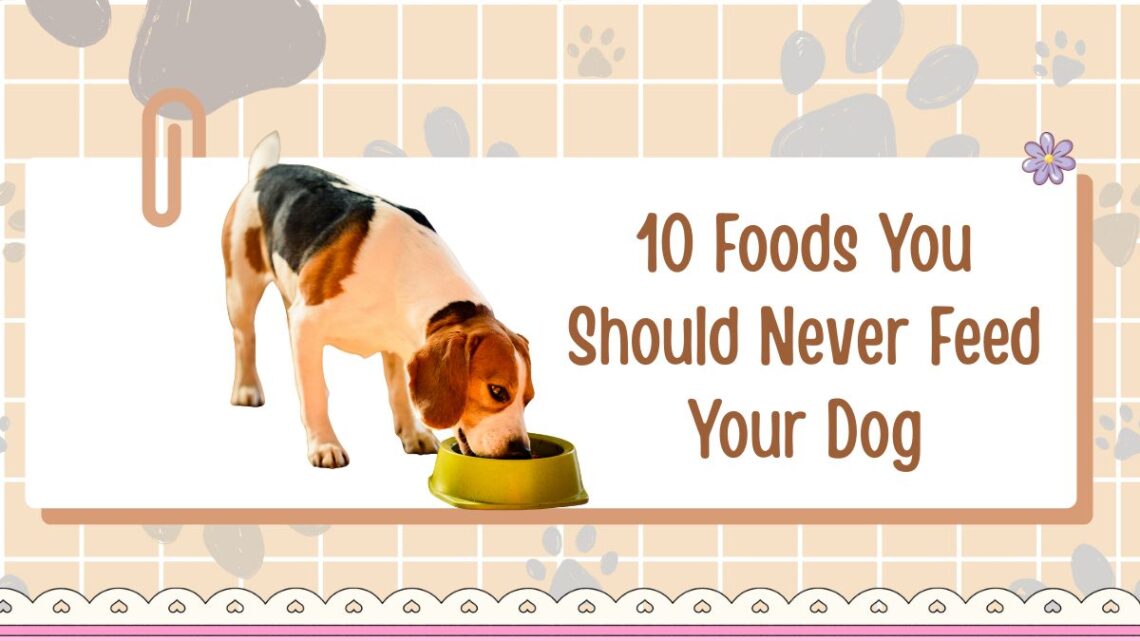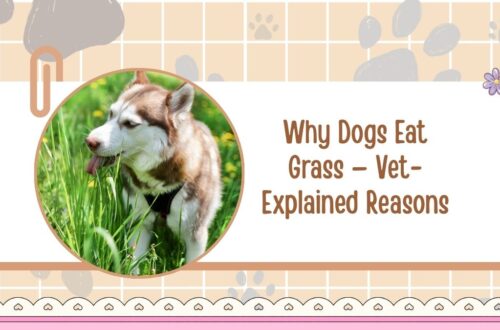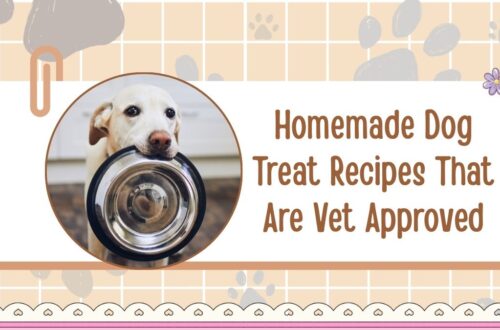Dogs are more than pets — they’re family. It’s natural to want to share your favorite foods with your furry friend, but what’s delicious to us can be toxic or deadly for them. Every year, thousands of dogs are rushed to veterinary clinics due to food poisoning caused by common household items.
From chocolate to grapes, from onions to xylitol, certain human foods can cause severe damage to your dog’s internal organs, even in tiny amounts. This article explores 10 foods you should never feed your dog, why they’re dangerous, what symptoms to watch for, and how to keep your pup safe — all based on the latest veterinary guidance.
Why Some Human Foods Are Toxic to Dogs
Dogs process foods differently because of their unique digestive and metabolic systems. While humans can handle caffeine, sugar alcohols, and certain plant compounds, dogs’ livers and kidneys lack the enzymes to break down many of these substances.
For example:
- Theobromine in chocolate stays in a dog’s system for days, poisoning organs.
- Xylitol, an artificial sweetener, triggers an insulin surge that crashes blood sugar levels.
- Grapes and raisins mysteriously damage the kidneys — even in small doses.
These foods may seem harmless, but dogs’ smaller body mass and slower metabolism amplify toxicity.
The Top 10 Dangerous Foods for Dogs (2025 Update)
| # | Food | Toxic Component | Health Impact | Common Symptoms |
|---|---|---|---|---|
| 1 | Chocolate & Cocoa | Theobromine, caffeine | Heart arrhythmia, seizures, death | Vomiting, tremors, restlessness |
| 2 | Grapes & Raisins | Unknown toxin | Kidney failure | Vomiting, loss of appetite, lethargy |
| 3 | Onions, Garlic & Chives | Thiosulfate | Red blood cell destruction | Pale gums, fatigue, anemia |
| 4 | Xylitol & Sugar-Free Gum | Sugar alcohol | Liver failure, hypoglycemia | Weakness, seizures, tremors |
| 5 | Macadamia Nuts | Unknown neurotoxin | Neurological dysfunction | Stiffness, tremors, high temperature |
| 6 | Avocado (Pit & Peel) | Persin | Gastrointestinal distress, choking | Vomiting, diarrhea, breathing issues |
| 7 | Alcohol / Yeast Dough | Ethanol, gas buildup | Alcohol poisoning, bloat | Vomiting, disorientation, coma |
| 8 | Caffeine (Coffee, Tea, Energy Drinks) | Methylxanthines | Nervous system overload | Restlessness, panting, seizures |
| 9 | Fatty Foods / Cooked Bones | Saturated fat, splinters | Pancreatitis, GI blockage | Abdominal pain, vomiting, fever |
| 10 | Certain Fruits & Veggies (Rhubarb, Mushrooms) | Solanine, oxalates | Kidney or liver failure | Tremors, drooling, weakness |
1. Chocolate & Cocoa – A Sweet Treat That Can Kill
Chocolate remains the #1 most reported pet toxin in the U.S. The culprit is theobromine, a compound dogs metabolize 10x slower than humans.
The darker and purer the chocolate, the deadlier it is.
- Baking chocolate contains about 390 mg of theobromine per ounce, enough to poison a 20-lb dog.
- Milk chocolate contains about 60 mg per ounce — still dangerous in large amounts.
Symptoms appear within 6–12 hours and include vomiting, rapid heartbeat, and seizures. Immediate vet care is critical.
2. Grapes & Raisins – Small Fruit, Big Danger
Even a few grapes or raisins can cause acute kidney failure in dogs.
The toxic agent remains unknown, but the effect is clear: vomiting within hours, followed by dehydration, lack of appetite, and lethargy.
In severe cases, kidney shutdown occurs within 24–72 hours, often fatal if untreated.
Never assume a “safe amount.” Even a single grape can cause harm.
3. Onions, Garlic & Chives – Hidden in Many Foods
These pantry staples contain thiosulfate, which damages dogs’ red blood cells and causes hemolytic anemia.
Even a few bites of onion-rich gravy, garlic bread, or stir-fry can be harmful — especially in smaller dogs.
Toxicity thresholds:
- As little as 15–30 g of onion per kg of body weight can trigger anemia.
If your dog eats food seasoned with onion or garlic, contact your vet immediately — symptoms like pale gums, fatigue, and dark urine may appear days later.
4. Xylitol – The Hidden Sweetener That Can Be Deadly
Xylitol is a sugar substitute found in gum, candy, peanut butter, protein bars, and baked goods. It’s harmless to humans but lethal to dogs.
Even a tiny amount (0.1 g/kg) can trigger a massive insulin release, dropping blood sugar to dangerous levels within minutes.
Severe cases lead to liver failure and death within 24 hours if untreated.
Check ingredient labels — “sugar-free” doesn’t mean “dog-safe.”
5. Macadamia Nuts – Small Snack, Big Risk
Macadamia nuts can cause neurological issues and hyperthermia in dogs.
Within 12 hours of ingestion, your dog might show:
- Muscle weakness (especially in hind legs)
- Vomiting
- Fever over 103°F
- Tremors or paralysis in severe cases
Even 5–6 nuts can make a 30-lb dog seriously ill.
Avoid all nut mixes and baked goods containing them.
6. Avocado – Healthy for Humans, Risky for Dogs
Avocado flesh isn’t acutely toxic, but it contains persin, a compound that can cause vomiting, diarrhea, and heart issues in dogs.
The real danger, though, lies in the pit — which can choke or block intestines if swallowed.
Fat-rich foods like avocado may also lead to pancreatitis, especially in smaller breeds.
7. Alcohol & Yeast Dough – Double Trouble
Alcohol depresses a dog’s central nervous system and lowers blood sugar.
Even small amounts from beer, wine, or fermented dough can cause:
- Disorientation
- Vomiting
- Seizures
- Coma
When raw yeast dough rises inside a dog’s stomach, it produces alcohol and gas, leading to dangerous bloating and ethanol poisoning.
Never let dogs lick batter or taste uncooked dough.
8. Caffeine – Not Just in Coffee
Caffeine is found in coffee, tea, sodas, energy drinks, and chocolate.
It stimulates the heart and nervous system — and dogs are far more sensitive than humans.
Toxic doses start at 9 mg/lb of body weight, meaning one energy drink can poison a medium-sized dog.
Symptoms include restlessness, rapid breathing, tremors, and even cardiac arrest in severe cases.
9. Fatty Foods & Cooked Bones – The Hidden Household Hazard
Leftovers like bacon, fried chicken skin, or buttery scraps are high in saturated fats that can inflame the pancreas.
Pancreatitis causes severe abdominal pain, vomiting, and fever — sometimes fatal without immediate care.
Cooked bones, especially poultry bones, splinter easily and can:
- Lacerate the throat or intestines
- Cause choking or obstruction
Raw bones or chew toys designed for dogs are safer alternatives.
10. Other Toxic Fruits & Vegetables
Not every fruit or vegetable is dog-friendly. Some plant compounds are dangerous in small doses.
Most Common Offenders:
- Rhubarb leaves: Contain oxalates that can cause kidney failure.
- Wild mushrooms: May contain deadly toxins.
- Unripe tomatoes and potato leaves: Contain solanine, toxic to dogs.
- Apple seeds & cherry pits: Contain cyanide compounds.
Safe alternatives:
Blueberries, carrots, cucumbers, apples (without seeds), and pumpkin are all dog-approved snacks rich in fiber and vitamins.
What To Do If Your Dog Eats Something Toxic
If your dog ingests any of these foods:
- Stay calm — quick action matters.
- Call your vet immediately — provide details about the food, quantity, and timing.
- Do NOT induce vomiting unless instructed by a vet.
- Save packaging or remnants for identification.
- Watch for warning signs like:
- Drooling or vomiting
- Rapid heartbeat
- Tremors or seizures
- Lethargy or unresponsiveness
Prompt treatment can mean the difference between recovery and tragedy.
Safe and Healthy Alternatives for Dog Treats
You don’t need to deprive your dog — there are plenty of vet-approved, nutritious options for rewarding good behavior:
| Safe Food | Benefits | Serving Tip |
|---|---|---|
| Carrots | Great for teeth, low-calorie | Serve raw or steamed |
| Pumpkin (plain) | Aids digestion | Mix a spoonful into meals |
| Apples (no seeds) | Rich in fiber & vitamin C | Slice thin for snacks |
| Blueberries | Antioxidants & low sugar | Use frozen as summer treats |
| Peanut Butter (no xylitol) | Protein & good fats | Stuff in chew toys |
| Cooked Chicken | Lean protein | Remove bones & seasoning |
| Sweet Potatoes | Fiber & beta-carotene | Bake and slice thin |
Always introduce new foods gradually and in small quantities to avoid stomach upset.
How to Keep Your Dog Safe at Home
- Secure your kitchen — Store all foods (especially chocolate, gum, and grapes) out of reach.
- Educate family members — Teach kids not to share snacks.
- Use dog-safe alternatives — Choose natural treats designed for canine digestion.
- Read ingredient labels carefully — Especially for peanut butter or baked goods.
- Create a “safe snack zone” — Keep your dog’s treats separate from human foods.
You can even keep a dog-safe treat jar in the kitchen as a substitute when your dog begs for table food.
Understanding Toxic Doses (For Awareness)
| Food | Potentially Toxic Amount | Approximate Example |
|---|---|---|
| Chocolate | 100–200 mg/kg theobromine | 2 oz dark chocolate for 30 lb dog |
| Grapes | As few as 4–5 grapes | Kidney failure risk |
| Onions | 15–30 g/kg | Half an onion for small dog |
| Xylitol | 0.1 g/kg | One stick of sugar-free gum for 10 lb dog |
| Macadamia nuts | 2 g/kg | 5–6 nuts for 20 lb dog |
Note: Always treat these numbers as reference only — individual tolerance varies by breed, size, and age.
Your dog’s health and longevity depend on your awareness and choices. Remember — what’s harmless to you can be fatal to them.
Avoiding these 10 toxic foods and opting for vet-approved snacks can prevent painful, costly emergencies.
A balanced, species-appropriate diet doesn’t just keep your dog safe — it improves energy, skin, coat health, and mood.
So next time those puppy eyes beg for a bite of chocolate cake, grab a carrot or dog biscuit instead. Love means keeping them healthy — one safe treat at a time.
FAQs
Yes, but only dog-safe foods like cooked chicken, plain pumpkin, or carrots. Avoid any food with seasoning, fat, or sugar substitutes.
Watch for vomiting, lethargy, loss of coordination, rapid breathing, or seizures. If these occur, seek immediate veterinary care.
No. Sensitivity varies, but no level is safe. Toxicity depends on breed, age, and metabolism — so always err on the side of caution






